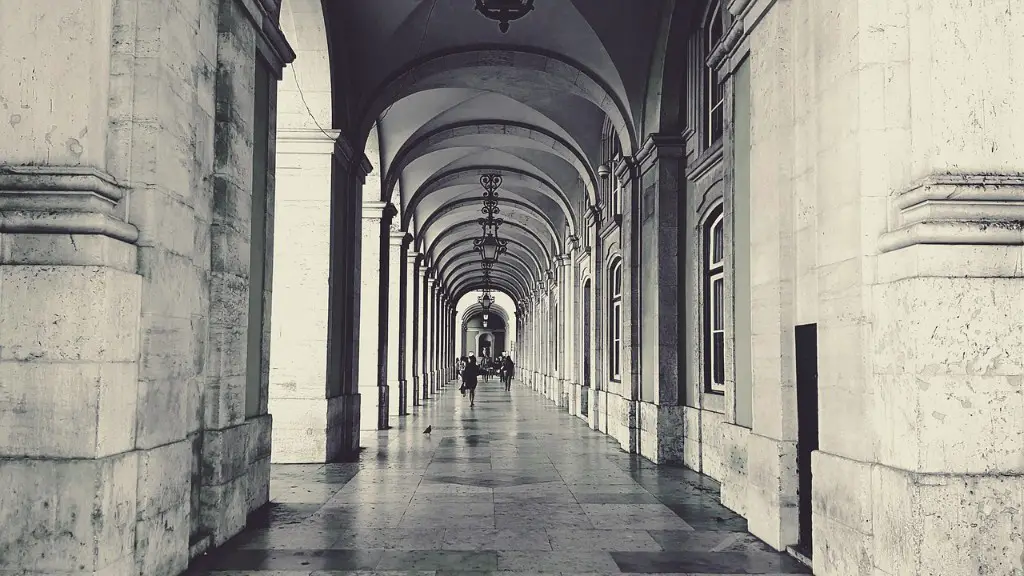Gothic architecture came about in the 12th century as an architectural style based largely on a Roman style of architecture called Romanesque. The days of the Romanesque period saw most major buildings (such as churches) constructed of large stone blocks. Little decorative features were added, losing the intricate classical designs which had previously been a prominent element of European castles and churches. Gothic architecture, on the other hand, saw a greater focus on style and decoration, developing more complex stone detailing, ribbed vaults and pointed spires. The use of higher and lighter walls along with the inventive use of ribbed vaults created more space inside the building while also contributing to its elaborate design.
It is commonly accepted by experts that the primary creator of Gothic architecture was a French monk named Abbot Suger. He was tasked with rebuilding the Abbey Church at St. Denis near Paris and was motivated to do something different from the Romanesque style. Suger’s vision was to purposefully create a sense of soaring. He sought to make the walls seem to float and, along the way, invented new ways of supporting those walls and ceilings. This desire to create vast interior spaces forms one of the primary principles of Gothic architecture.
The increased focus on design was driven not only by technical advancements and innovative thinking, but also by a larger religious and spiritual movement occurring during this period. This period was known as the height of the Christian faith being practiced in Europe. People were being called to offer more of themselves to their faith and Gothic architecture provided a practical way to do this. Gothic architecture became a reflection of the emotion and passion of the people, creating incredible works of beauty to glorify their faith.
Despite the advancements that made it possible to build larger, taller, lighter and more intricate structures, the more technical aspects of Gothic architecture still relied heavily on the input of skilled craftsmen and laborers. These workers had to know how to cut, carve, and shape the stone in order to create the intricate designs. Additionally, many of the elements of Gothic architecture, such as the ribbed vaults, still relied on existing Romanesque technologies.
The Gothic architecture movement was incredibly influential. Buildings of the period such as Chartres cathedral, Westminster Abbey, Notre-Dame de Paris, and others are still considered among the most beautiful and significant buildings in the world. Gothic architecture has long been a source of inspiration for many design elements across a variety of fields.
Societal and Cultural Implications
The building of these highly influential and beautiful buildings also had a lasting impact on society and culture. Although a reflection of devotion to the Christian faith, Gothic architecture also became a sign of status and wealth. Gothic cathedrals and churches were expensive to build and often took years to construct. Because of the time and resources required to build them, they quickly became symbols of wealth and power.
The fact that such large financial resources were typically put into creating the designs and the building of Gothic cathedrals and churches, shows how much Europeans at the time valued their faith. It also showed that these churches were seen as important places of gathering and worship – not only for the wealthy but for the common folk as well.
Gothic architecture was also an important cultural phenomenon because it provided a platform for artistic expression. The intricate stone carvings, stained glass windows and other decorative elements not only served a practical purpose in strengthening the structure of the building, but they were also used to tell the stories of some of the most important figures of folk lore and biblical tales. As such, these incredible Gothic structures held a great significance in the lives of many Europeans of the time.
Confidence and Creativity of the Movement
The confidence and creativity of the Gothic movement have also been praised throughout history as having a major influence on the development of architecture and culture. Gothic architecture replaced the massive stone blocks used in the Romanesque period with thinner, more delicate structures that relied on ribbed vaults and other inventive designs to keep them standing. This level of innovation, combined with a mastery of craftsmanship, allowed for the creation of some of the most iconic buildings in history.
Gothic architecture helped pave the way for many of the modern design trends we see today. The influence of Gothic architecture can still be seen in everything from the intricate patterns and curves of modern churches to the ornate facades of old Victorian buildings. Gothic architecture was a bold statement of creativity, innovation and faith that changed the course of architecture and design forever.
Economic Impact
The building of Gothic architecture had a large economic impact. The amount of time and resources required to construct these buildings meant that there was a great demand for skilled laborers and craftsmen. This was beneficial for the economy as it created jobs for those skilled in carpentry, masonry and other trades.
The economic impact of Gothic architecture was not limited to just jobs, but also to the increased prosperity the buildings brought to the region. Gothic architecture became a symbol of wealth, and it attracted more people to the region and increased the number of tourists coming to visit the sites. This meant more money was spent in the region, providing an economic boost to the area.
Legacy of Gothic Architecture
Gothic architecture left an indelible mark not only on architecture and design, but also on the people and society of the time. Its influence can still be seen in a wide variety of things ranging from modern churches to the facades of old buildings. It is an incredible example of the potential of innovation and creativity when inspired by religious faith. Although the principles of Gothic architecture have been refined, modernized, and adapted over the centuries, the core elements remain largely unchanged.
Gothic architecture not only provided a platform for artistic expression, but also allowed for the creation of some of the most iconic buildings in history. It was also an important cultural phenomenon, as it was the reflection of a large religious and spiritual movement occurring during the time. Finally, it had a lasting economic impact in terms of providing jobs for skilled laborers and craftsmen, as well as increasing the prosperity of the region.



